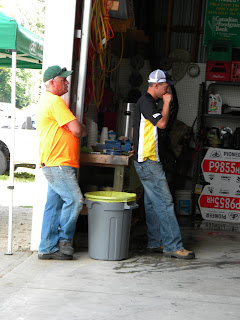1.Maturity is variable. We expected to see maturity differences due to the wide range of planting dates and hybrid selection. What has surprised some growers is the maturity differences within the field.
Comments like "there is a big difference in moistures from load to load" have been common. What they are witnessing is the impact of the wet spring. Corn in the weak areas of the field, due to mostly poor drainage and compaction, has died early. The healthy areas have stayed alive and are greener.
Those of us who are grain producers will make similar observations when we roll the combines out. But, it will be more yield variability than maturity. Healthy corn is going to yield as well as last year. However, our field averages will not maintain the same pace.
The other message for grain producers will be standability. The corn plants are weak and will not stand well if fall storms move through.
2.Yields are very good and the grain content in the silage is good. Some producers are telling me they are filling the bunk with fewer acres than last year. This is another strong indicator that grain yields will be very respectable in our local area.
I may humbly suggest it might be good for your local Pioneer sales representative. More than one customer has indicated they want more Pioneer next year, particularly 34A85. This hybrid has consistently proven to be an outstanding performer in the silage arena
I guess you could say 34A85 is "King of the Hill".
There is still a lot of silage to cut and the forecast is indicating another week of rain and showers. Corn plants continue to mature even in wet weather and while maturity is not a problem yet, silage harvest moistures will continue to drop.
It is my observation over the years that producers have made more mistakes by taking silage too wet than by taking it too dry. Folks like Pioneer's Robert Larmer, who knows a lot more than I do, would advise you to simlpy tighten up the processor when silage gets a little dry. Make sure every kernel gets damaged. Dry silage can still make temendous feed.
Add a quality inoculant like 11CFT and you are good to go.
Speaking of silage processors, a customer made an observation regarding Pioneer this week. Pioneer nutritionists have been advocates of silage processing for many years. My customer had the opinion that the only reason Pioneer promoted processing was to make up for their inferior silage hybrids. A good silage hybrid did not need processing was the reasoning. Now that he uses a processor he sees what it can do and admitted he had been wrong. More feed in the silo and better feed coming out.
That's what it is all about.
























